‘Pinocchio’ Is the Most Guillermo del Toro-iest Movie Yet
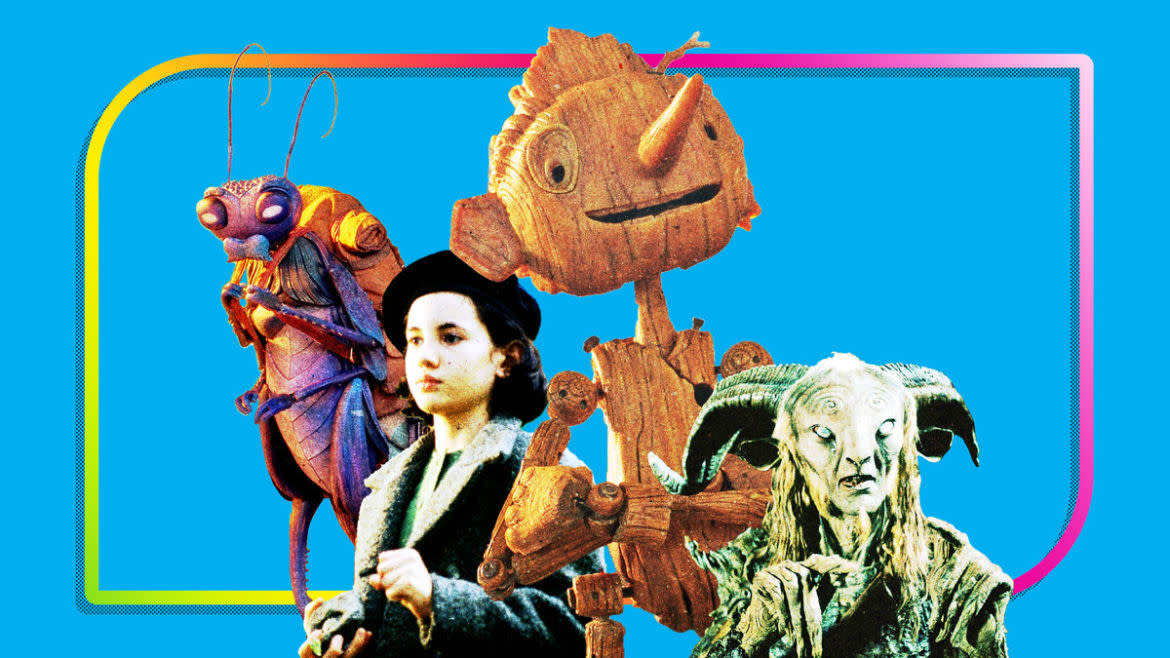
- Oops!Something went wrong.Please try again later.
It should surprise no one that Guillermo del Toro has long held a personal fascination with Pinocchio. After all, can you think of another director who has such a soft spot for kids and their bugs?
Del Toro’s stop-version interpretation of Pinocchio debuted on Netflix Friday, continuing a fascination with children and insects that’s been apparent since his feature debut, Cronos, and has stretched through most of his films. (As we all know, in Pinocchio, our titular wooden boy befriends a talking cricket.) The director has described Pinocchio as the third entry in a spiritual trilogy, alongside The Devil’s Backbone and Pan’s Labyrinth. Speaking with Total Film earlier this year, the director pointed out that the three films all depict “children during war, in a way, or innocence lost.” (The latter films both take place in Francisco Franco’s Spain.)
In all three of these films, the children’s relationship with these small creatures becomes a metaphor for their relationship with fascism. And the thematic threads that bind this trilogy run deeper than the obvious shared motifs—kids, war, bugs. Each film explores a distinctly painful facet of the human condition. The backdrop of war forces del Toro’s child protagonists to grow up too fast, highlighting in the process the way fascism places itself in direct conflict with the human spirit—with a person’s connection to the world, to other people, and to themselves.
Del Toro’s Pinocchio is not the same story you might remember from the Disney adaptation. (Translation: The wooden boy does not smoke a cigar and turn into a donkey this time around.) Instead, del Toro’s retelling falls somewhere in between Walt’s vision and Carlo Collodi’s original 1883 novel.
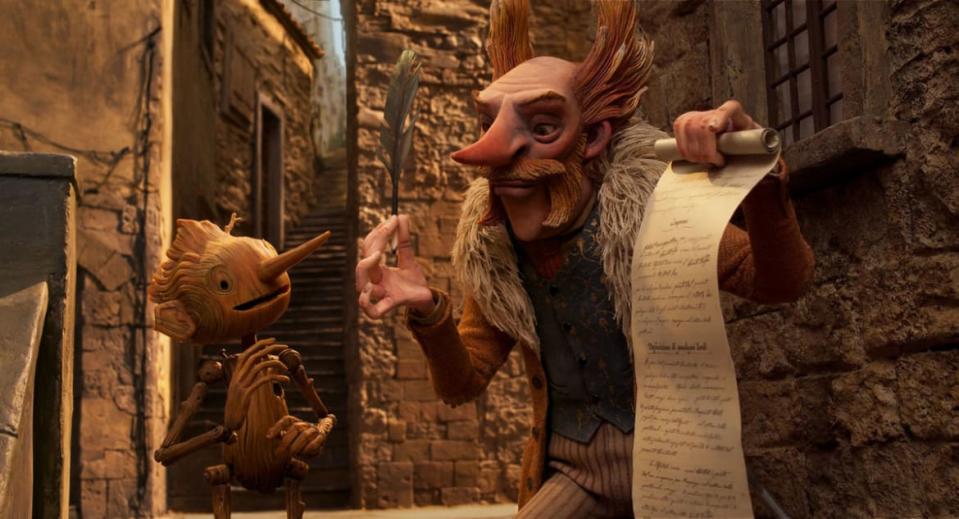
Pinocchio (voiced by Gregory Mann) and Count Volpe (voiced by Christoph Waltz) in Guillermo del Toro’s Pinocchio
Unsurprisingly, given its source material and its director’s admitted status as a lapsed Catholic, Pinocchio is all about temptation. The wooden puppet with no strings has a surprisingly human id—meaning, he wants to touch, chase, and play with basically everything in sight. When his papa tells him not to go to church and his talking cricket begins to sing him a song about why he must obey, what does Pinocchio do? Run straight to church, of course! As with the original tale, however, the consequences get bleak pretty fast—especially when the magical puppet falls in with Count Volpe, an abusive circus ringleader who lures him away from Gepetto with the promise of adventures and sweets.
That’s not to say, however, that del Toro has produced a pious, moralistic tale. Temptation comes in many forms, and while Pinocchio’s initial transgressions don’t earn him any points with the otherworldly creature who’s granted him life, they pale in comparison to those of the adults around him. Pinocchio’s restraint might waver at the sight of hot chocolate, but both Count Volpe and, more importantly, the authoritarian figure Podesta prove themselves to be exploitative monsters.
Guillermo Del Toro Has Done the Impossible: Make a Good ‘Pinocchio’ Remake
While Count Volpe sweeps Pinocchio into his circus—stealing all of his earnings and threatening the small puppet whenever he steps out of line—Podesta sees him only as cannon fodder. Because he is not a real boy, Pinocchio can’t die; he always comes back to life after a period of time in the afterlife. It is this distinction, he learns, that makes him inhuman: real boys’ lives are so precious because they’re inevitably brief. But Podesta cares about none of this; he just kidnaps Pinocchio and drafts him into the army, where he hopes the puppet might become the ultimate killing machine.
In the end, when Pinocchio sacrifices himself to save Gepetto’s life, he proves that while he might’ve strayed from the straight and narrow path once in a while, he has remained pure. It’s the adults who hurt him who’ve truly succumbed to their temptation for money and power. And it’s the talking cricket—named Jiminy in the Disney version, but unnamed in Collodi’s novel and del Toro’s update—who must help Pinocchio navigate all of it. As Pinocchio’s conscience, the cricket struggles at first to explain why he should obey the rules. But by the end? He’s yelling in rage for the universe to cut him some slack.
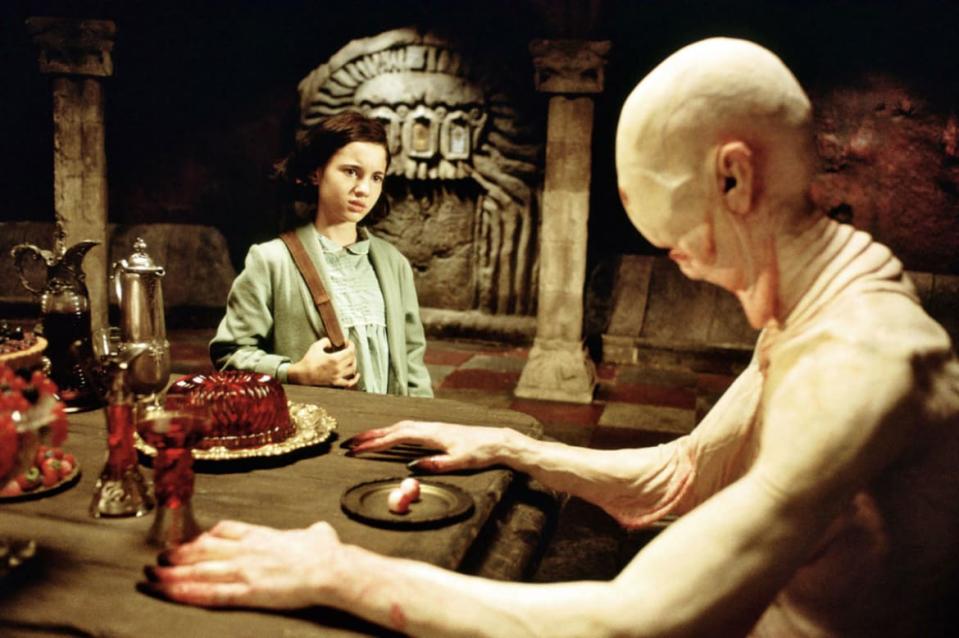
Ivana Baquero and Doug Jones in Pan’s Labyrinth
In many ways, Pinocchio might almost feel redundant next to Pan’s Labyrinth—a film that also features a young protagonist who also occasionally messes up in her quest to save her eternal kingdom, and who also dies while sacrificing herself for someone else only to discover that in doing so, she’s earned a second life. But temptation does not appear to be Pan’s Labyrinth’s chief concern. The film invests far more in the question of obedience.
Pan’s Labyrinth takes place in 1944—years after the Spanish Civil War’s end. Ofelia and her very pregnant mother travel to the mountainous backcountry, where her stepfather, Captain Vidal, is working to wipe out guerilla Republican fighters. Vidal demands order at all times, and from all people. He meticulously cares for a smashed pocket watch that first belonged to his father—who famously died fighting for Spain in Morocco, where he beat his watch against a rock as he died so that his son would know his exact time of death. To Vidal, the only “decent way to die” is at war—the ultimate act of obedience, a sacrifice of oneself to one’s country.
Guillermo del Toro on the Drug War: ‘Every Time Somebody Uses Drugs, It’s Like Having a Gun’
Del Toro’s villains never have much use for children, whose creativity, spirituality, and impulsivity provides a perfect foil for fascists’ blind obedience. His narratives also tend to explore the consequence of that philosophy: young girls’ dreams collapse as they realize their only role in this system is to provide more baby boys for the state, and the boys, in turn, grow up too young as either orphans or would-be killing machines. In Pan’s Labyrinth, we can tell from early on that Ofelia will confound her fascistic stepfather’s wishes—beginning with the moment the young girl strays from his compound and into the woods on the trail of a large grasshopper.
Throughout Pan’s Labyrinth, we get a taste of the strictly enforced gender roles that undergirded Franco’s vision for Spain. Vidal forces Ofelia’s mother, Carmen, into a wheelchair upon arrival, even as she insists that she can walk just fine. It’s the first of many hints that Vidal will only disempower the women at his side. He insisted that Carmen and Ofelia travel to meet him in the first place because, “a son should be born wherever his father is.” (Never mind that he has no way of knowing the child will be a boy.) And when Carmen’s pregnancy goes south, Ofelia overhears Vidal quietly telling the doctor that if he must choose, he should save the infant—not her mother, the woman carrying it. After all, only one can carry on Vidal’s family name.
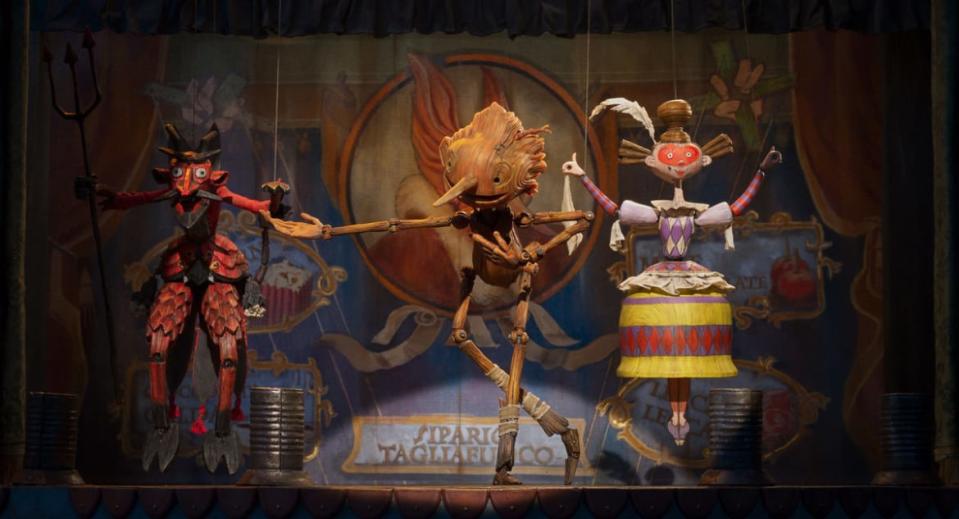
Guillermo del Toro’s Pinocchio
Ofelia breaks Vidal’s rules not because she’s given into temptation like Pinocchio, but because she has a strong sense of self. When Carmen gives Ofelia an expensive new dress for one of Vidal’s dinners, she traipses into the woods, gets mud all over her new shoes, and leaves the dress on a branch—where it promptly blows into a pile of muck. This is not an act of defiance, per se, as much as it is a statement of independence. Ofelia’s mother wants her to wear the dress because it makes her look like a “princess,” but thanks to the fawn she met in the labyrinth, Ofelia knows she is a princess already; she has a moon shaped birthmark on her shoulder to prove it, just as the fawn said she would. Because of this, Ofelia knows that her power, her divinity, lies within. Vidal’s rules are inconsequential to her—as is the role he’d like her to play.
Ofelia does give into temptation once—when she starts gobbling down grapes in the infamous Pale Man’s lair after the fawn told her not to eat or drink anything. The fawn becomes furious and tells her that any opportunity that once existed to save her kingdom is over; she will forever be stuck in this wretched Earthly place, bound by mortality to be forgotten with the passage of time. It’s an uncharacteristically harsh moment that makes more sense in the end—when the fawn gives Ofelia one more chance and demands that she give over her baby brother for a blood sacrifice. Even as the fawn promises he will take only a pin prick of blood, the young girl refuses.
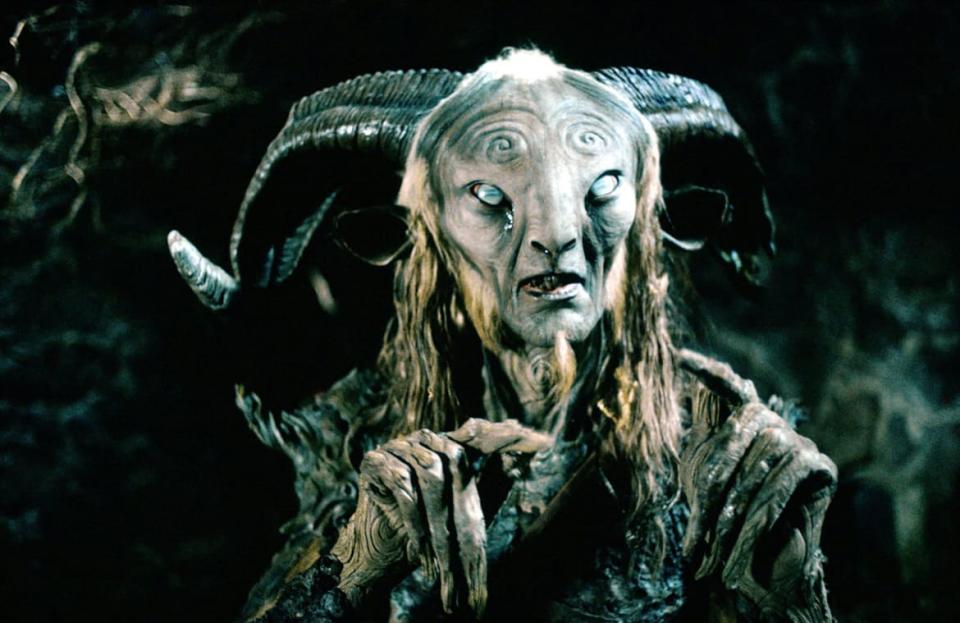
Doug Jones in Pan’s Labyrinth
As we find out when Vidal shoots Ofelia and she comes back to life in another world as an immortal princess, this was a test. Whether we believe that she’s actually gained immortality or that it’s merely a hallucination, it’s clear that in refusing to obey the fawn and sacrifice her brother, Ofelia has proven her purity.
Pan’s Labyrinth and Pinocchio’s endings might basically be fraternal twins, but in other ways, del Toro’s Pinocchio feels more closely related to The Devil’s Backbone.
In Pinocchio, the elderly carpenter Gepetto loses his son, Carlo, when a stray bomb strikes their church. In The Devil’s Backbone, a stray bomb lands in the orphanage courtyard but never ignites—standing, instead, as a visual reminder of the constant peril in which these children live. In the beginning of Pinocchio, the stringless puppet faces bullying from Podesta’s son, Candlewick, who’s desperate to prove to his violent father that he can be a “real” man. Meanwhile, in Devil’s Backbone, Carlos initially struggles to win over some of his rougher peers, including Jaime—all of whom, we later discover, live in fear of a violent caretaker, Jacinto. In both films, young boys are forced to learn how to kill.
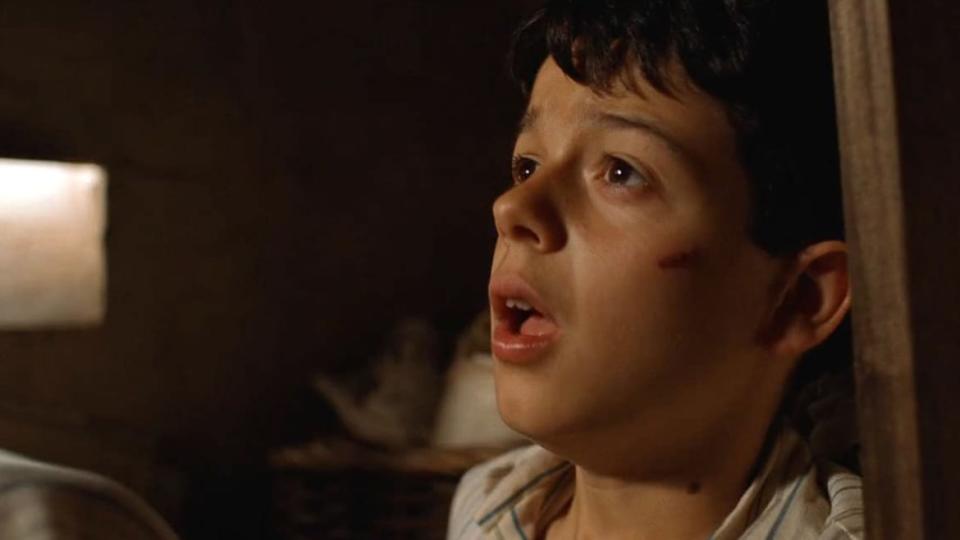
Carlos, played by Fernando Tielve, in The Devil’s Backbone
But while Pinocchio ambles out on all kinds of adventures, the boys of The Devil’s Backbone are trapped. Their parents were all Republican soldiers and officers killed in the war, and save for two caretakers—the kindly Dr. Casares and the doting Conchita—the operators of this orphanage are terrible. There’s Carmen, the administrator, and the violent Jacinto—who once lived at the facility as an orphan until Carmen took up an affair with him when he was only 17 years old. Jacinto, we find out, once murdered one of the boys, Santi, who found him trying to break into the orphanage’s safe.
For a microcosm of this story, one can once again look to the bugs. Well, in this case, technically they’re molluscs. Carlo arrives at the orphanage with a few slugs in a box. (You know, boy stuff.) The slugs, like the boys, are trapped—but unlike the boys, they seem to receive a fair amount of kindness and care. In various scenes, the boys can be seen doting on the slugs—or at least, they let the creatures slide up their limbs in a sort of symbiotic moment of peace. The slugs seem to represent not only the suffocating setting in which the boys find themselves, but also their innate purity, even in the face of impossible circumstances.
This seems to be the strongest emotional constant in all three of del Toro’s “children in war” films: Even in these awful places, and even in spite of their fractured sense of community, they refuse to harm the smallest, most fragile creatures among them. Try as the adults in their lives might to force their obedience, these children simply refuse to follow the rules when the rules don’t make sense.
Get the Daily Beast's biggest scoops and scandals delivered right to your inbox. Sign up now.
Stay informed and gain unlimited access to the Daily Beast's unmatched reporting. Subscribe now.

